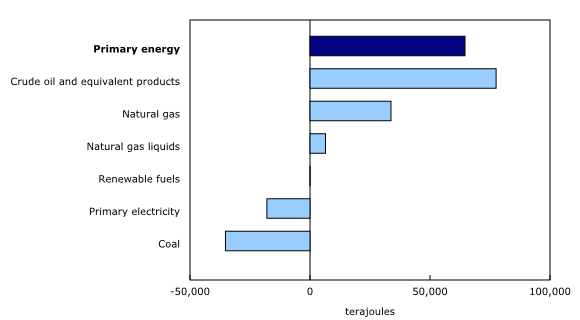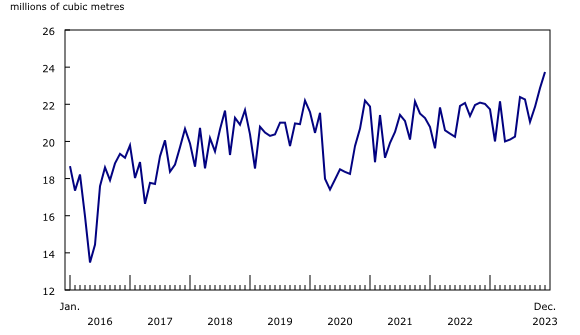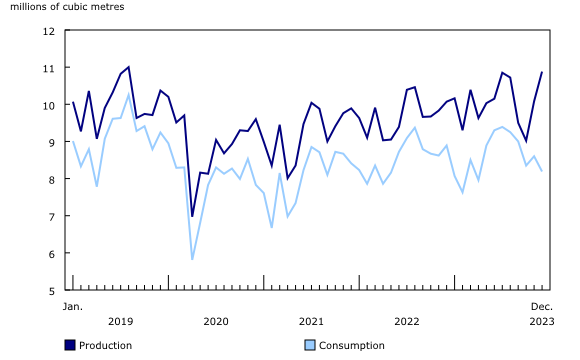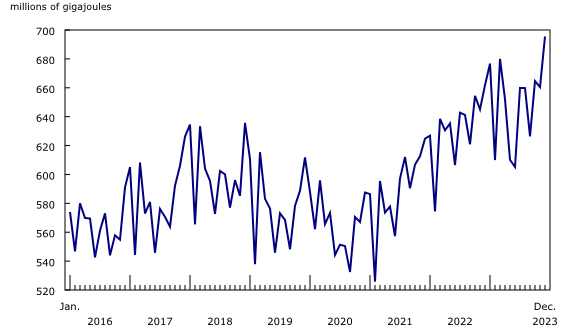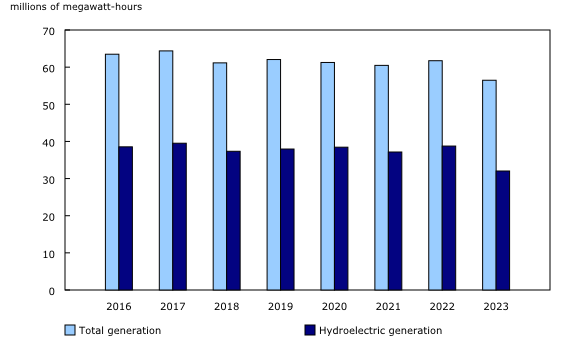Energy statistics, December 2023
Released: 2024-03-01
In December, primary energy production rose 3.2% year over year, with crude oil (+8.1%) leading the increase. At the same time, secondary energy production increased 2.9% with refined petroleum (+3.1%) gaining the most.
For more information on energy in Canada, including production, consumption, international trade, and much more, please visit the Canadian Centre for Energy Information portal and follow #energynews on social media.
Coming soon in StatsCAN Plus, the 2023 energy annual reviews for electricity, crude oil, refined petroleum products, and natural gas.
Crude oil production continues to rise
Maintenance work at several crude oil producing facilities in the fall of 2023 contributed to efficiency gains and higher levels of output. As a result, December recorded the third consecutive monthly year-over-year increase and the highest production volume since the start of the series in 2016. Production of crude oil and equivalent products climbed 8.1% year over year in December 2023 to 26.4 million cubic metres.
The overall increase was largely driven by oil sands extraction which rose 10.7% to 17.6 million cubic metres in December. Production of synthetic crude (+13.9% to 6.9 million cubic metres) and non-upgraded crude bitumen (+8.7% to 10.7 million cubic metres) both reached new record monthly volumes in December. Closing inventories were up from November, although still down 4.4% from December 2022 in part due to crude oil exports which continued to rise.
Exports of crude oil and equivalent products increased 11.6% to a record 20.5 million cubic metres in December 2023. The Trans Mountain pipeline expansion is expected to nearly triple export capacity to the Pacific Coast. Originally set to open in early 2024, the expansion is now expected to be complete sometime in the second quarter.
Production of finished petroleum products increases in December
Production of finished petroleum products climbed 8.1% year over year in December 2023 to 10.9 million cubic metres. Finished motor gasoline (+5.8%), distillate fuel oil (+5.0%) and kerosene-type jet fuel (+31.4%) all posted gains.
In contrast, consumption of finished petroleum products fell 7.9% year over year in December to 8.2 million cubic metres, mainly due to a 12.3% drop in consumption of finished motor gasoline.
Natural gas production levels reach series high
Production of marketable natural gas rose 5.1% year over year to 695.5 million gigajoules in December, continuing the upward trend observed since mid-2021. This was the highest level of production since this series began in 2016.
Deliveries of natural gas to Canadian consumers fell 5.9% in December, partially due to reduced demand for heating as above-average temperatures were seen across much of the country in the month. Deliveries to the industrial sector (+1.1%) partially offset decreases in the residential (-21.3%) and commercial and institutional (-15.1%) sectors.
Exports of natural gas declined 2.7% to 314.1 million gigajoules in December, down from the series high recorded in December 2022. Exports of natural gas usually peak in winter when demand in the United States is the highest.
Inventories of natural gas remained elevated in December 2023, up 35.3% largely due to high production levels and reduced demand from Canadian residential and commercial consumers.
Hydroelectricity generation remains low in December
Total electricity generated in Canada declined 8.5% year over year to 56.5 million megawatt-hours (MWh) in December. As was the case for several previous months, hydroelectric generation led the decrease due to dry conditions across much of Canada and was down 17.3% in December.
Year over year, nuclear generation rose 16.0% in December, partially offsetting the overall decrease. Nuclear generation was low in December 2022 due to maintenance and refurbishments.
Exports of electricity to the United States were down 36.2% year over year in December 2023 to 3.3 million MWh. The decline was mostly due to Quebec (-48.6%), which grappled with dry conditions through much of 2023. Meanwhile, imports jumped 169.3% to 2.6 million MWh, largely because of drought-stricken British Columbia and Manitoba.
Did you know we have a mobile app?
Get timely access to data right at your fingertips by downloading the StatsCAN app, available for free on the App Store and on Google Play.
Note to readers
The survey programs that support the "Energy statistics" release include:
- Crude oil and natural gas (survey number 2198; tables 25-10-0036-01, 25-10-0055-01 and 25-10-0063-01). Data from November 2023 have been revised.
- Energy transportation and storage (survey number 5300, tables 25-10-0075-01 and 25-10-0077-01). With the next release of Energy statistics (reference month January 2024), revisions will be made back to January 2020 to reflect updated information.
- Natural gas transmission, storage and distribution (survey numbers 2149, 5210 and 5215; tables 25-10-0057-01, 25-10-0058-01 and 25-10-0059-01). Data from November 2023 have been revised.
- Refined petroleum products (survey number 2150, table 25-10-0081-01).
- Renewable fuel plant statistics (survey number 5294, table 25-10-0082-01).
- Electric power statistics (survey number 2151, tables 25-10-0015-01 and 25-10-0016-01).
- Coal and coke statistics (survey numbers 2147 and 2003, tables 25-10-0045-01 and 25-10-0046-01).
The consolidated energy statistics table (25-10-0079-01) presents monthly data on primary and secondary energy by fuel type (crude oil, natural gas, electricity, coal, etc.) in terajoules and supply and demand characteristics (production, exports, imports, etc.) for Canada. The table uses data from a variety of survey and administrative sources. For more information, please consult the Consolidated Energy Statistics Table: User Guide.
Data are subject to revisions. Energy data and other supporting data used in the text are revised on an ongoing basis for each month of the current year to reflect new information provided by respondents and updates to administrative data. Historical revisions are also performed periodically.
Definitions, data sources and methods for each survey program are available under the respective survey number.
The Energy Statistics Program relies on data collected from respondents and administrative sources.
Data in this release are not seasonally adjusted.
Occasionally, data from Environment and Climate Change Canada are referenced by the Energy Statistics Program using Cooling Degree Days (CDDs) or Heating Degree Days (HDDs) as a measure of temperature. CDDs reflect the relationship between outdoor temperatures and the need to cool indoors to maintain room temperature. As temperatures outside rise, the number of CDDs increases. HDDs are the opposite and reflect the need to heat indoors to maintain room temperature. As temperatures outside fall, the number of HDDs increases.
Contact information
For more information, or to enquire about the concepts, methods or data quality of this release, contact us (toll-free 1-800-263-1136; 514-283-8300; infostats@statcan.gc.ca) or Media Relations (statcan.mediahotline-ligneinfomedias.statcan@statcan.gc.ca).
- Date modified:



